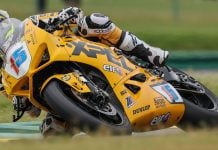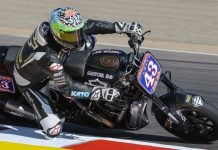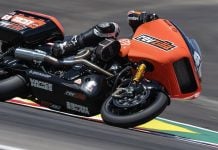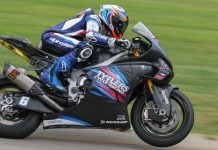From a press release:
AMA Pro Racing partners with TWI International for global television coverage of AMA Superbike
AMA Pro Racing, the leading sanctioning body for motorcycle sport in the U.S., announced today it has signed an international television rights agreement with TWI International, the television arm of International Management Group (IMG). Under terms of the partnership, TWI will formulate agreements with international television networks to telecast AMA Chevy Trucks U.S. Superbike Championship races.
This agreement will continue to build a greater global following of the U.S. Superbike Championship brand of racing, arguably the most competitive continental road-racing championship in the world. TWI has already signed agreements with Dubai Radio & Television and British broadcaster BskyB to show AMA Superbike races in the UK & Eire. British Sky Broadcasting is a leading provider of sports, movies, entertainment and news whose channels are received by over 10 million households in the UK and Eire.
Additional deals are in the works and will be announced soon.
AMA Superbike riders, teams, sponsors and OEMs will benefit greatly from the exposure to a much larger and broader international fan base.
“We know many of our top Superbike athletes have a devoted overseas following, and now those race fans can enjoy a Superbike battle between Mat Mladin and Nicky Hayden from the comfort of their own living rooms,” said Chris Bradley, AMA Pro Racing associate vice president of commercial development.
“We are extremely pleased to have this relationship with AMA Pro Racing,” said Peter Smith, senior international vice president, TWI International. “The U.S. Superbike Championship already has a very positive reaction from international buyers. The future of U.S. Superbike racing is strong and we look forward to expanding its popularity into the overseas markets.”
AMA Pro Racing CEO Scott Hollingsworth said, “We are very happy to have TWI as a partner in the development of our international television rights. Our goal is to not only grow the sport here, but also expand its exposure on a worldwide scale, increasing value for all stakeholders.”
The AMA Chevy Trucks U.S. Superbike Championship and support classes are followed by millions of fans around the world, at race events, on television broadcasts and the Internet. Last year, 375,000 fans attended Superbike races, with an average attendance of more than 34,000 per event, an 11.5 percent increase over the 2000 season.
The AMA U.S. Superbike Championship traces its roots back to 1934, when the AMA first organized motorcycle road racing in the United States. In 1976, the AMA created the U.S. Superbike Championship to provide an affordable, level playing field for professional race teams, and as a platform for motorcycle manufacturers to showcase their production sport-performance models.
Today, the AMA Chevy Trucks U.S. Superbike Championship stands as the world’s premiere national Superbike championship, and tours with the AMA Pro Honda Oils U.S. Supersport Championship and four additional top-caliber bike classes: Genuine Suzuki Accessories Superstock, MBNA 250 Grand Prix, Lockhart Phillips Formula Xtreme and Buell Pro Thunder.
About TWI
TWI is the largest independent producer, packager and distributor of sports programs in the world and produces 6,000 hours of original programming each year for distribution to more than 200 territories. It is the program making arm of Mark McCormack’s IMG and has production centers in London, Hong Kong, New Delhi, New York, Seoul and Sydney plus over 40 sales offices around the globe.
TWI’s sports news agency collaboration with APTN, SNTV, serves 200 broadcasters world wide with a reach of 850 million and TWI produces web sites for international brand names like the Brazilian national Football Team, Manchester United, the Chinese Premier League and the Indian Cricket Team.
TWI’s Features & Documentaries Division has a wide range of international successes under its belt including Century, a 13-part co-production with British Pathe, and the multi-award winning The Second World War in Colour, which has sold throughout the globe, and its documentary series Britain at War in Colour won the British Academy Award for Best Factual Series [BAFTA] in 2001.













